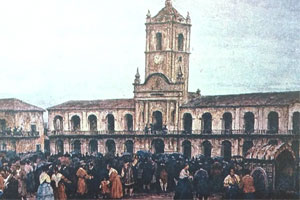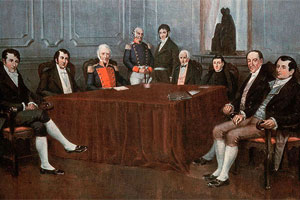May Revolution, a road through its causes, its timeline and curiosities.
Let us trace our minds back to the year 1810, when it all began… Buenos Aires, in that instance, was the capital of the Viceroyalty of Río de la Plata; This means a fairly extensive territory with what we currently know as Uruguay, Bolivia, Paraguay and Brazil. This entire area was under the mandate of Viceroy Baltasar Hidalgo de Cisneros, selected by the Supreme Central Board of Spain, for which he ruled on behalf of the King.
When the news arrived from Europe, that the King abdicated in favor of Napoleon Bonaparte, and, in turn, the Junta was dissolved, many locals began to rise up against the Viceroy, arguing that his position no longer had legitimacy and they wanted his resignation.
Faced with this situation, there were several causes for deciding on the famous May Revolution of 1810.
CAUSES OF THE MAY REVOLUTION
- Declaration of Independence of the United States.
- Ideas of the French Revolution.
- Abdication of Fernando VII.
- Strong Local Army: The Locals (criollos) resisted against the British Army, alone, without help from Spain. This helped build its confidence.
- Economic recession: Spain imposed its monopoly on the colonies.
- Political resentment against Spaniards: Public positions never went to the hands of the Criollos, which led to a rivalry against the Spaniards.

CHRONOLOGY
May 17, 1810: It is confirmed that France controlled the largest part of the Iberian Peninsula and the Junta had been dissolved. Creoles begin to question the Legitimacy of Cisneros in charge.
May 18, 1810: Demand of an Open Town Hall by the Creoles, with the idea of debate about the continuity of the Viceroyalty.
May 21, 1810: The Plaza de la Victoria (current Plaza de Mayo) is filled with armed patriots, demanding that Open Town Hall. Finally, Cisneros accepts.
May 22, 1810: Open Town Hall. The entrance to the Plaza with weapons is controlled, so that only the Creoles arrive at the Cabildo.
May 24, 1810: Viceroy Cisneros is appointed as president of the New Board, but the population takes it as a mockery of bad taste.
May 25, 1810: The people meet again in the Plaza to demand the dissolution of the Board and the subsequent resignation of Cisneros. Finally, the resignation of Cisneros is achieved and a New Board is formed to represent all sectors of society.
 CONSEQUENCES OF THE REVOLUTION
CONSEQUENCES OF THE REVOLUTION
- Cisneros resigns from his position.
- The First Board is established, which was the first Independent government of the Argentine Republic.
- The War for Independence begins.
- Viceroyalty of Río de la Plata loses its internal cohesion. A territory that included different people, with different thoughts and interests. Many of them were willing to go against the rules of Buenos Aires.
- Change in the way of thinking about Political Power, related to the governed. Until then, the population accepted royal authority for the common good. Now, the concept of Popular Sovereignty was put in the first place. The people have the right to choose their representatives.
This is how the May Revolution was carried out in 1810, which, six years later, led to the Declaration of Independence.






Leave A Comment